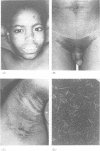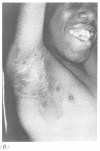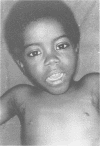Abstract
Leprechaunism is a rare autosomal recessive disorder associated with extreme insulin resistance with paradoxical hypo-glycaemia. It is characterised by prenatal and postnatal growth retardation, reduced subcutaneous tissue, coarse features, acanthosis nigricans, enlarged genitalia, and death in the first year of life. Defects in both the insulin receptor and postreceptor steps of the insulin action pathway have been reported. At the molecular level, several mutations have been described. The patients reported here are from a Yemeni family with a syndrome of insulin resistance similar to leprechaunism in which the parents are second cousins and five of their eight children are affected. However, the phenotypes seem to be less severe than the classical leprechaunism previously described. All the children are alive (oldest 11 years), there is normal subcutaneous tissue, and a normal growth pattern in some of them. It may be that this is a milder type of leprechaunism with a better prognosis, perhaps caused by a different type of mutation from those previously described.
Full text
PDF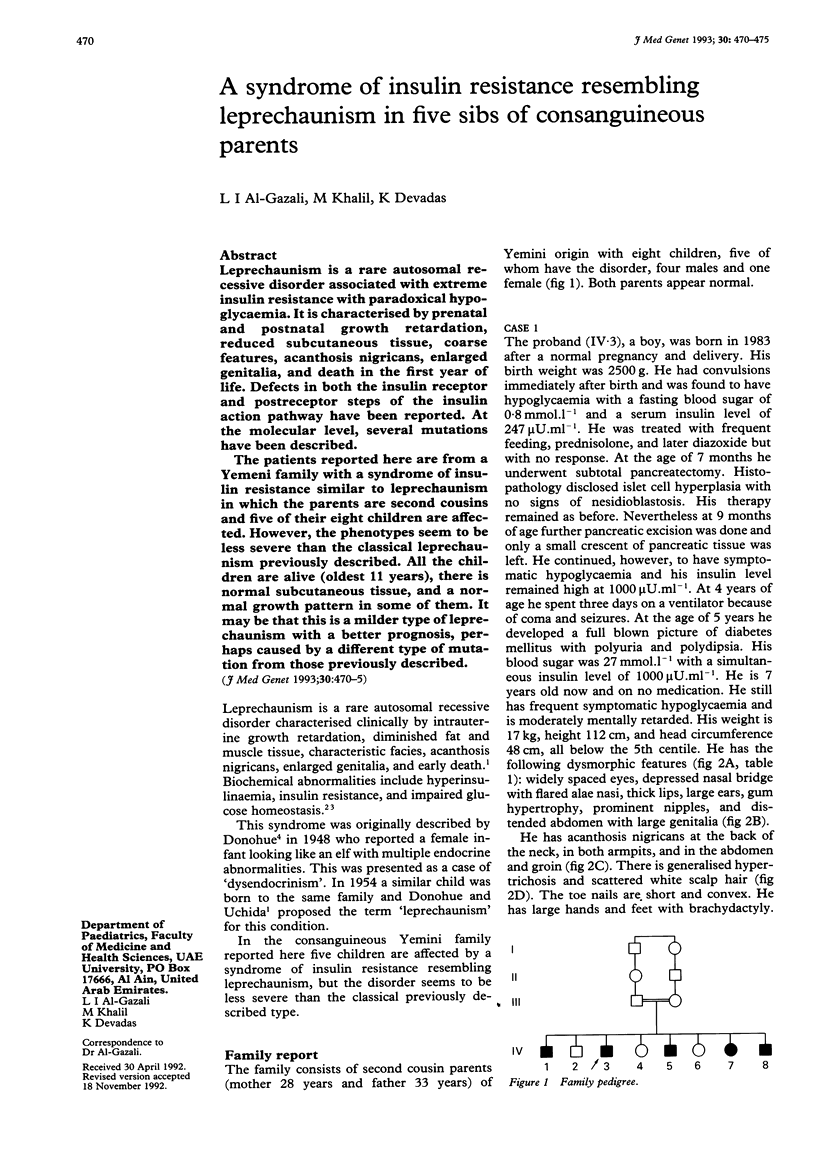
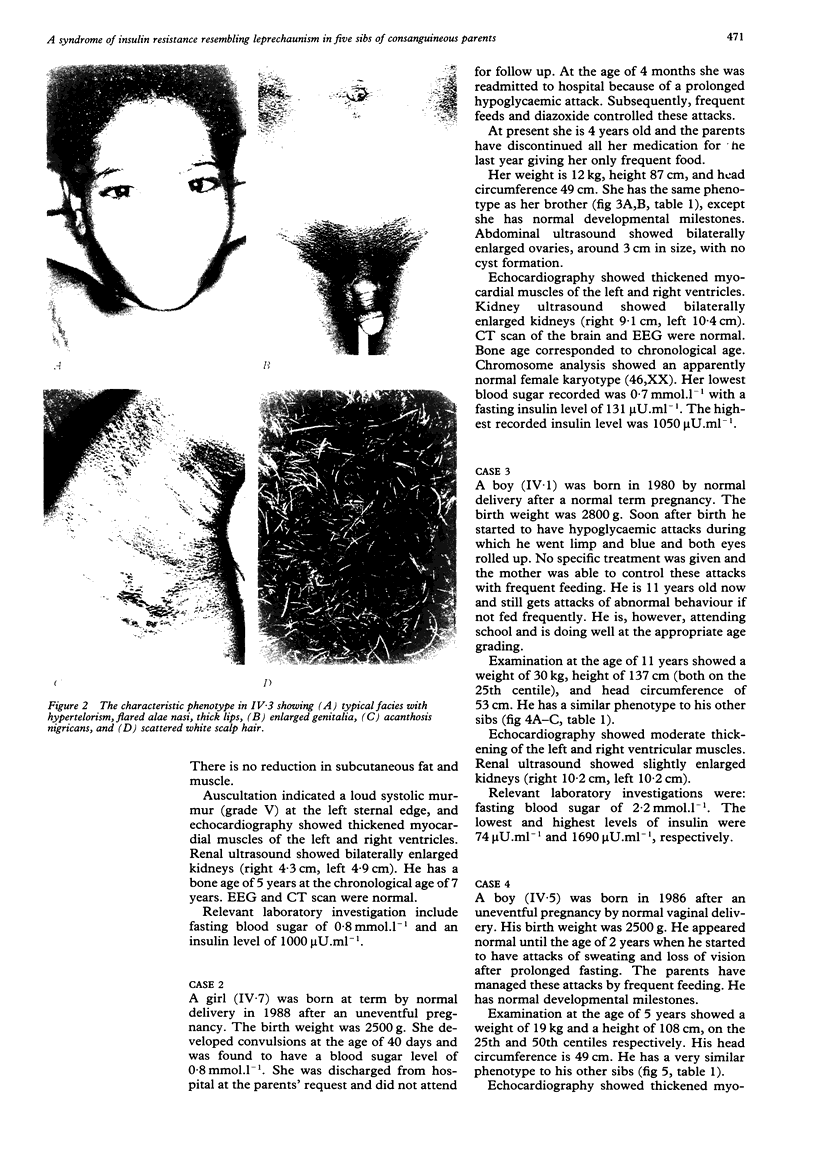
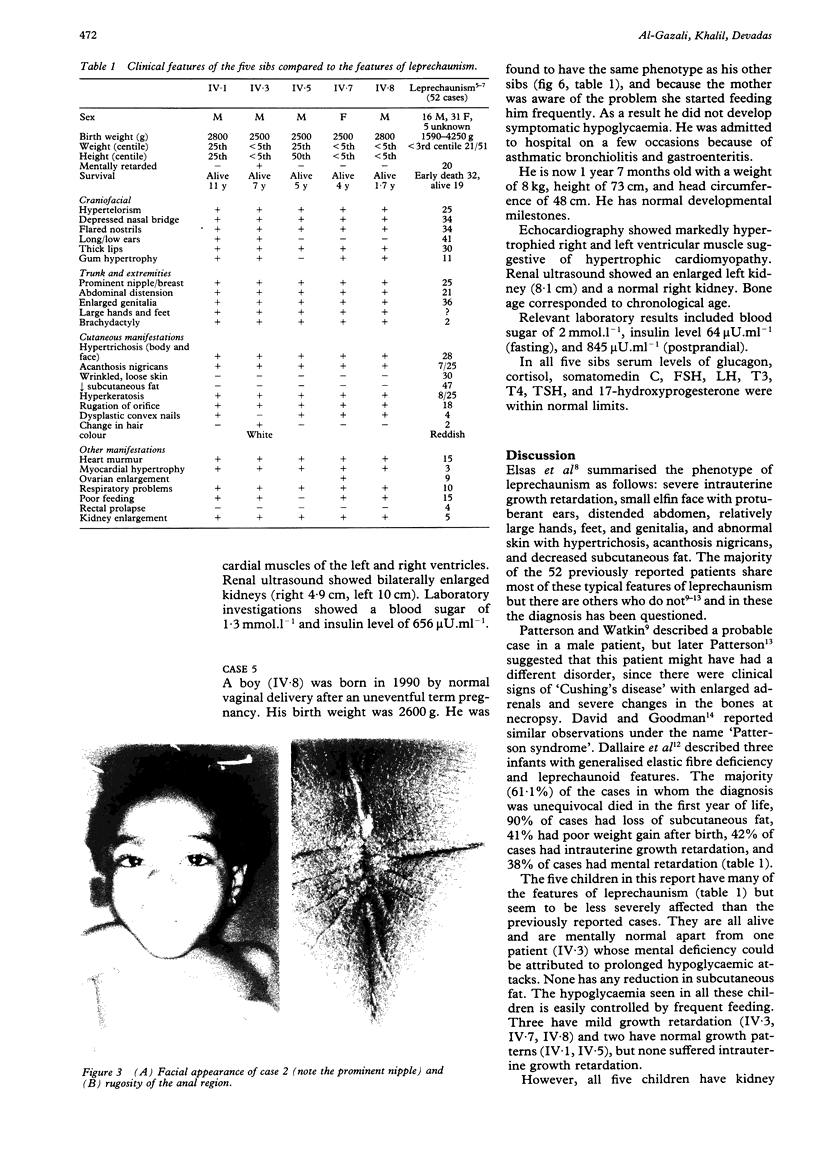

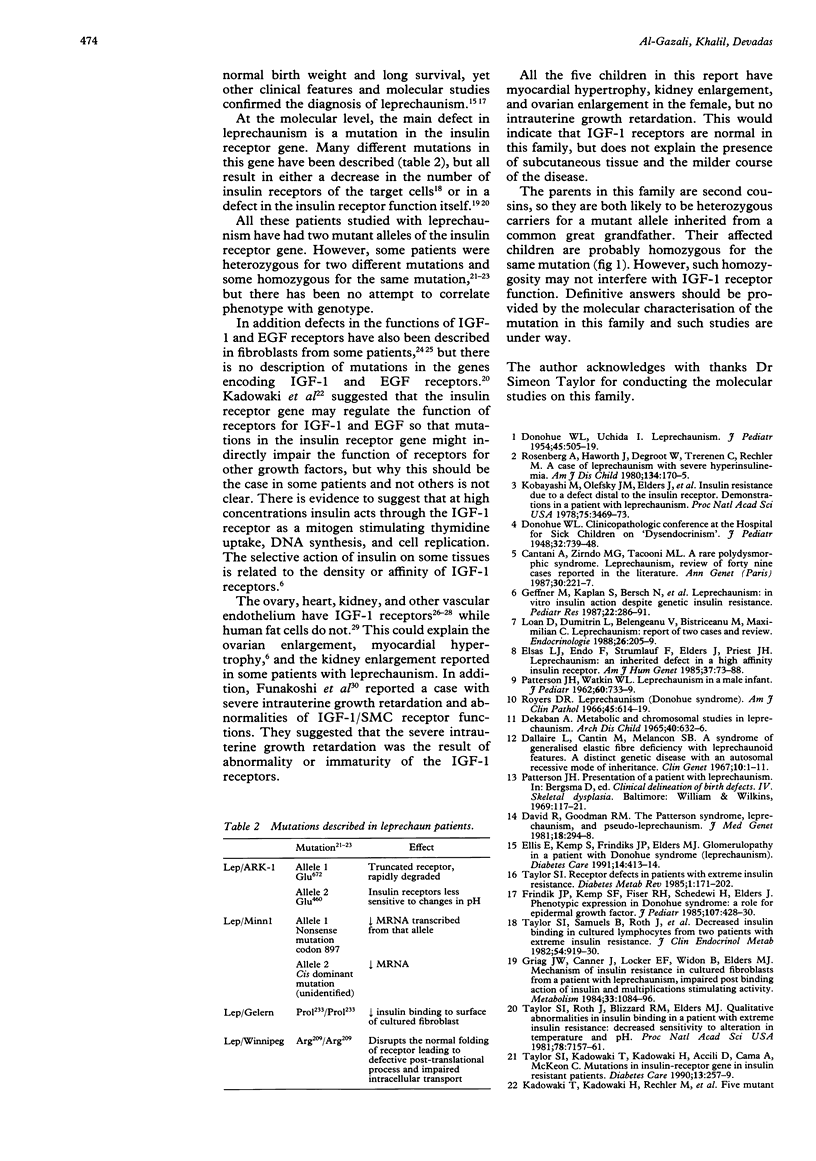
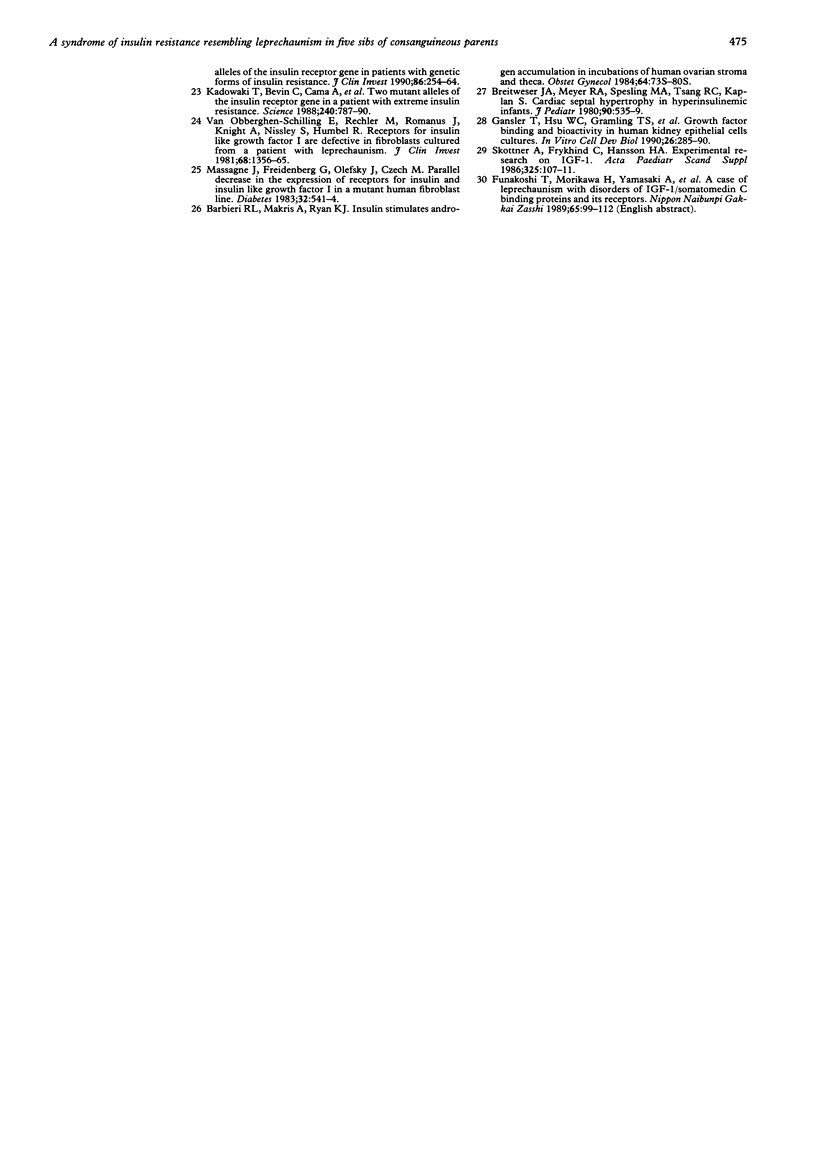
Images in this article
Selected References
These references are in PubMed. This may not be the complete list of references from this article.
- Barbieri R. L., Makris A., Ryan K. J. Insulin stimulates androgen accumulation in incubations of human ovarian stroma and theca. Obstet Gynecol. 1984 Sep;64(3 Suppl):73S–80S. doi: 10.1097/00006250-198409001-00019. [DOI] [PubMed] [Google Scholar]
- Breitweser J. A., Meyer R. A., Sperling M. A., Tsang R. C., Kaplan S. Cardiac septal hypertrophy in hyperinsulinemic infants. J Pediatr. 1980 Mar;96(3 Pt 2):535–539. doi: 10.1016/s0022-3476(80)80862-6. [DOI] [PubMed] [Google Scholar]
- Cantani A., Ziruolo M. G., Tacconi M. L. Un syndrome polydysmorphique rare: le lepréchaunisme. Revue des quarante-neuf cas publiés dans la littérature. Ann Genet. 1987;30(4):221–227. [PubMed] [Google Scholar]
- Craig J. W., Larner J., Locker E. F., Widom B., Elders M. J. Mechanisms of insulin resistance in cultured fibroblasts from a patient with leprechaunism: impaired post-binding actions of insulin and multiplication-stimulating activity. Metabolism. 1984 Dec;33(12):1084–1096. doi: 10.1016/0026-0495(84)90092-1. [DOI] [PubMed] [Google Scholar]
- DONOHUE W. L., UCHIDA I. Leprechaunism: a euphemism for a rare familial disorder. J Pediatr. 1954 Nov;45(5):505–519. doi: 10.1016/s0022-3476(54)80113-2. [DOI] [PubMed] [Google Scholar]
- Dallaire L., Cantin M., Melançon S. B., Perreault G., Potier M. A syndrome of generalized elastic fiber deficiency with leprechaunoid features: a distinct genetic disease with an autosomal recessive mode of inheritance. Clin Genet. 1976 Jul;10(1):1–11. doi: 10.1111/j.1399-0004.1976.tb00001.x. [DOI] [PubMed] [Google Scholar]
- David T. J., Webb B. W., Gordon I. R. The Patterson syndrome, leprechaunism, and pseudoleprechaunism. J Med Genet. 1981 Aug;18(4):294–298. doi: 10.1136/jmg.18.4.294. [DOI] [PMC free article] [PubMed] [Google Scholar]
- Dekaban A. Metabolic and chromosomal studies in leprechaunism. Arch Dis Child. 1965 Dec;40(214):632–636. doi: 10.1136/adc.40.214.632. [DOI] [PMC free article] [PubMed] [Google Scholar]
- Ellis E. N., Kemp S. F., Frindik J. P., Elders M. J. Glomerulopathy in patient with Donohue syndrome (leprechaunism). Diabetes Care. 1991 May;14(5):413–414. doi: 10.2337/diacare.14.5.413. [DOI] [PubMed] [Google Scholar]
- Elsas L. J., Endo F., Strumlauf E., Elders J., Priest J. H. Leprechaunism: an inherited defect in a high-affinity insulin receptor. Am J Hum Genet. 1985 Jan;37(1):73–88. [PMC free article] [PubMed] [Google Scholar]
- Frindik J. P., Kemp S. F., Fiser R. H., Schedewie H., Elders M. J. Phenotypic expression in Donohue syndrome (leprechaunism): a role for epidermal growth factor. J Pediatr. 1985 Sep;107(3):428–430. doi: 10.1016/s0022-3476(85)80527-8. [DOI] [PubMed] [Google Scholar]
- Funakoshi T., Morikawa H., Yamasaki A., Kobayashi A., Ueda Y., Mochizuki M., Matsuo M., Nakamura H., Matsuo T., Itoh H. [A case of leprechaunism with disorders of insulin-like growth factor-I(IGF-I)/somatomedin C(SMC) binding protein and its receptor]. Nihon Naibunpi Gakkai Zasshi. 1989 Feb 20;65(2):99–112. doi: 10.1507/endocrine1927.65.2_99. [DOI] [PubMed] [Google Scholar]
- Gansler T., Hsu W. C., Gramling T. S., Robinson K. A., Buse M. G., Blocker N., Roy L., Green S., Garvin A. J., Sens D. A. Growth factor binding and bioactivity in human kidney epithelial cell cultures. In Vitro Cell Dev Biol. 1990 Mar;26(3 Pt 1):285–290. doi: 10.1007/BF02624459. [DOI] [PubMed] [Google Scholar]
- Geffner M. E., Kaplan S. A., Bersch N., Lippe B. M., Smith W. G., Nagel R. A., Santulli T. V., Jr, Li C. H., Golde D. W. Leprechaunism: in vitro insulin action despite genetic insulin resistance. Pediatr Res. 1987 Sep;22(3):286–291. doi: 10.1203/00006450-198709000-00010. [DOI] [PubMed] [Google Scholar]
- Ioan D., Dumitriu L., Belengeanu V., Bistriceanu M., Maximilian C. Leprechaunism: report of two cases and review. Endocrinologie. 1988 Jul-Sep;26(3):205–209. [PubMed] [Google Scholar]
- Kadowaki T., Bevins C. L., Cama A., Ojamaa K., Marcus-Samuels B., Kadowaki H., Beitz L., McKeon C., Taylor S. I. Two mutant alleles of the insulin receptor gene in a patient with extreme insulin resistance. Science. 1988 May 6;240(4853):787–790. doi: 10.1126/science.2834824. [DOI] [PubMed] [Google Scholar]
- Kadowaki T., Kadowaki H., Rechler M. M., Serrano-Rios M., Roth J., Gorden P., Taylor S. I. Five mutant alleles of the insulin receptor gene in patients with genetic forms of insulin resistance. J Clin Invest. 1990 Jul;86(1):254–264. doi: 10.1172/JCI114693. [DOI] [PMC free article] [PubMed] [Google Scholar]
- Kobayashi M., Olefsky J. M., Elders J., Mako M. E., Given B. D., Schedwie H. K., Fiser R. H., Hintz R. L., Horner J. A., Rubenstein A. H. Insulin resistance due to a defect distal to the insulin receptor: demonstration in a patient with leprechaunism. Proc Natl Acad Sci U S A. 1978 Jul;75(7):3469–3473. doi: 10.1073/pnas.75.7.3469. [DOI] [PMC free article] [PubMed] [Google Scholar]
- Massague J., Freidenberg G. F., Olefsky J. M., Czech M. P. Parallel decreases in the expression of receptors for insulin and insulin-like growth factor I in a mutant human fibroblast line. Diabetes. 1983 Jun;32(6):541–544. doi: 10.2337/diab.32.6.541. [DOI] [PubMed] [Google Scholar]
- Rogers D. R. Leprechaunism (Donohue's syndrome). A possible case, with emphasis on changes in the adenohypophysis. Am J Clin Pathol. 1966 May;45(5):614–619. doi: 10.1093/ajcp/45.5.614. [DOI] [PubMed] [Google Scholar]
- Rosenberg A. M., Haworth J. C., Degroot G. W., Trevenen C. L., Rechler M. M. A case of leprechaunism with severe hyperinsulinemia. Am J Dis Child. 1980 Feb;134(2):170–175. doi: 10.1001/archpedi.1980.02130140044014. [DOI] [PubMed] [Google Scholar]
- Skottner A., Fryklund L., Hansson H. A. Experimental research on IGF-1. Acta Paediatr Scand Suppl. 1986;325:107–111. doi: 10.1111/j.1651-2227.1986.tb10376.x. [DOI] [PubMed] [Google Scholar]
- Taylor S. I., Kadowaki T., Kadowaki H., Accili D., Cama A., McKeon C. Mutations in insulin-receptor gene in insulin-resistant patients. Diabetes Care. 1990 Mar;13(3):257–279. doi: 10.2337/diacare.13.3.257. [DOI] [PubMed] [Google Scholar]
- Taylor S. I. Receptor defects in patients with extreme insulin resistance. Diabetes Metab Rev. 1985;1(1-2):171–202. doi: 10.1002/dmr.5610010109. [DOI] [PubMed] [Google Scholar]
- Taylor S. I., Roth J., Blizzard R. M., Elders M. J. Qualitative abnormalities in insulin binding in a patient with extreme insulin resistance: decreased sensitivity to alterations in temperature and pH. Proc Natl Acad Sci U S A. 1981 Nov;78(11):7157–7161. doi: 10.1073/pnas.78.11.7157. [DOI] [PMC free article] [PubMed] [Google Scholar]
- Taylor S. I., Samuels B., Roth J., Kasuga M., Hedo J. A., Gorden P., Brasel D. E., Pokora T., Engel R. R. Decreased insulin binding in cultured lymphocytes from two patients with extreme insulin resistance. J Clin Endocrinol Metab. 1982 May;54(5):919–930. doi: 10.1210/jcem-54-5-919. [DOI] [PubMed] [Google Scholar]
- Van Obberghen-Schilling E. E., Rechler M. M., Romanus J. A., Knight A. B., Nissley S. P., Humbel R. E. Receptors for insulinlike growth factor I are defective in fibroblasts cultured from a patient with leprechaunism. J Clin Invest. 1981 Nov;68(5):1356–1365. doi: 10.1172/JCI110383. [DOI] [PMC free article] [PubMed] [Google Scholar]



